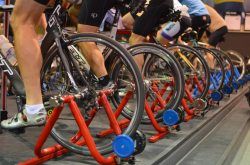Part 1: Calories Out – Calories In
In a past article, Bob Hayssen outlined the relationship between kilojoules (KJ’s) and calories. He pointed out that although, mathematically, one calorie is equal to 4.2 KJ’s, the human body is only 25% efficient at best. This relationship works out rather nicely for cyclists, especially since power meters have become common, because it means that 1 KJ burned on the bike is roughly equal to 1 calorie that needs to be obtained through the diet. Knowing this, here are some tips to help you make those KJ’s work for you most effectively.
One critical piece of information is your resting metabolic rate (RMR), or the amount of calories your body consumes just to sustain vital organs. In general, RMR for men is between 1900-2100 calories and for women between 1,400-1,600 calories. However, RMR is increased through cardiovascular exercise and lean muscle mass, but decreases with age and loss of lean tissue. There are several online calculators available to help you determine your individual RMR based on age, weight, height and gender.
Once you know your RMR, you can add your daily KJ expenditure to that value to determine your total daily caloric needs. Since your training load (volume + intensity) is not the same every day, your caloric intake should not be either. This is especially important as we come into the off-season and both volume and intensity of training decrease. The simplest concept of nutrition and weight maintenance is calories in = calories out. If you continue to consume the same number of calories you have become accustomed too, you will end up with a calorie surplus, which leads to weight gain.
That being said, many athletes are interested in attaining a lighter body weight, and the off-season is the time to do it. Training stress is low, so it is much easier to recover from workouts. This means it is ok to consciously consume fewer calories than you burn during your workouts because your body will still be able to recover without the adverse effects it would have had on training and racing during the season.
The best practice is to make sure you continue to fuel well before, during and after your workouts, so that you have plenty of energy to get through them, but aim to eat less during the rest of the day. You also do not want to build up a large caloric debt at one time, but rather have a small deficit each day that leads to gradual weight loss on the order of 1-2 lbs a week, or less if you are already relatively fit. So if your RMR is 1,800 calories a day, and you burned 750 KJ’s during your workout, your total caloric load is 2,550 calories. A pound of fat contains 3,500 calories, so aiming for a deficit of 500-750 calories per day will put you on track to lose that safe amount each week, meaning for this particular day you should limit intake to 1,800-2,050 calories.
Here are a few final tips to help manage weight loss.
- Eat less in the evenings when you will be less active.
- Drink more water. We often confuse thirst and hunger, so sometimes a full glass will curb your cravings.
- Be sure to get enough fat, protein and fiber. These three important components of food not only play a number of important roles in the body, but also contribute to satiety and can help prevent you from eating more than you need.

